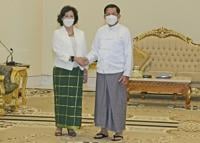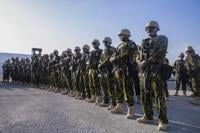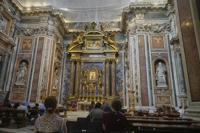SINJAR, Iraq (AP) — When Rihan Ismail returned to her family’s home in the heartland of her Yazidi community, she was sure she was coming back for good.
She had yearned for that moment throughout long years of captivity.
militants had abducted then-adolescent Ismail as they rampaged through Iraq’s Sinjar district, killing and enslaving thousands from the .
As they moved her from Iraq to Syria, she clung to what home meant to her: a childhood filled with laughter, a community so tight knit the neighbor’s house was like your own. After her captors took her to Turkey, she finally managed to get ahold of a phone, contact her family and plan a rescue.
“How could I leave again?” Ismail, 24, told The Associated Press last year, soon after returning to her village, Hardan.
Reality quickly set in.
The house where she lives with her brother, a police officer, and his wife and toddler, is one of the few still standing in the village. A school down the street houses displaced families who have nowhere else to go.
Her father and younger sister are still missing. In a cemetery on the village edge, three of her brothers are buried along with 13 other local men and boys killed by IS and discovered in a mass grave.
Ismail passes it every time she has an errand to a neighboring town.
“You feel like you’re dying 1,000 deaths between here and there,” she said.
Deep connections persist for a homeland changed by horrors
A decade after the IS assault, members of the Yazidi community have been trickling back to their homes in Sinjar. But despite their homeland’s deep emotional and religious significance, many see no future there.
There’s no money to rebuild destroyed homes. Infrastructure is still wrecked. Multiple armed groups carve up the area.
And the landscape is haunted by horrific memories. In August 2014, militants stormed through Sinjar, determined to erase the tiny, insular religious group they considered heretics. They killed men and boys, sold women into sex slavery or forced them to convert and marry militants. Those who could, fled.
It has been seven years since IS was defeated in Iraq. But as of April 2024, only 43% of the more than 300,000 people displaced from Sinjar had returned, according to the International Migration Organization.
Some fear that if Yazidis don’t return, the community may lose its identity.
“Sinjar is the Yazidi center of gravity,” said Hadi Babasheikh, the brother and office manager of the late Yazidi spiritual leader who held the position during IS’ atrocities. “Without Sinjar, Yazidism would be like a cancer patient who’s dying.”
This strategically located remote corner of northwest Iraq near the Syrian border has been the Yazidis’ home for centuries. Villages are scattered across a semi-arid plain dotted with sheep, a cement factory and the occasional liquor store.
Rearing up from the flatland are the Sinjar Mountains, a long, narrow range considered sacred by the Yazidis. Legend says Noah’s ark settled on the mountain after the flood. Yazidis fled to the heights to escape IS, as they have done in past bouts of persecution.
In Sinjar town, the district center, soldiers lounge in front of small shops on the main street. A livestock market brings buyers and sellers from neighboring villages and beyond. Here and there, reconstruction crews work among piles of cinder blocks.
But in outlying areas, signs of the destruction — collapsed houses, abandoned fuel stations — remain everywhere. Water networks, health facilities and schools, and even religious shrines have not been rebuilt. Sinjar town’s main Sunni Muslim district remains a stretch of rubble; the occupants have not returned, facing hostility from their former Yazidi neighbors who view them as IS collaborators.
The central government in Baghdad and authorities in the semi-autonomous northern Kurdish region have been wrestling over Sinjar, where each backed a rival local government for years.
That dispute is now playing out in a debate over the displacement camps in the Kurdish region housing many of those who fled Sinjar.
Camp closures loom, leaving Yazidis torn on whether to stay or go
Earlier this year, Baghdad ordered the camps to be closed by July 30 and offered payments of 4 million dinars (about $3,000) to occupants who leave.
Karim al-Nouri, deputy minister for the displaced, said this month that difficulties in returning to Sinjar “have been overcome” and that getting the displaced back is “an official, humanitarian and moral imperative.”
But Kurdish authorities say they won’t evict the camp residents.
Sinjar “is not suitable for human habitation,” said Khairi Bozani, an advisor to the Kurdish regional president, Nechirvan Barzani.
“The government is supposed to move people from a bad place to a good place and not vice versa.”
Khudeida Murad Ismail refuses to leave the camp in Dohuk, where he runs a makeshift store selling eggs, instant noodles, pacifiers and hair henna. Leaving would mean losing his livelihood, and the payout wouldn’t cover rebuilding his house, he said.
If the camps shut down, he said he would remain in the area, rent a home and look for other work.
He acknowledged that if many Yazidis stay away from Sinjar, other groups will likely populate their areas. That saddens him, he said, “but there’s nothing I can do.”
But the camp closure order and relocation payments have prompted an increase in returns.
On June 24, Barakat Khalil’s family of nine joined a convoy of trucks piled with mattresses, blankets and household goods, leaving the town in Dohuk that had been their home for nearly a decade.
They now live in a small, rented house in Sinjar town. They fixed its broken doors and windows and are gradually furnishing it, even planting geraniums.
Their old home, in a nearby village, is destroyed. A humanitarian organization removed the rubble, leaving nothing but the foundation, but couldn’t help them rebuild. Khalil had spent seven years building the house, gradually saving money from his work in construction.
“We stayed in it for two months and then they (IS militants) came and blew it up,” he said.
Now, “it’s a totally new life — we don’t know anybody here,” said Khalil’s 25-year-old daughter, Haifa Barakat. She’s the only family member who is working, in the pharmacy of the local hospital.
Although life in Sinjar is tolerable for now, she worries about security.
Tensions among various militias in Sinjar raise safety concerns
Different parts of the territory are patrolled by the Iraqi army and Kurdish peshmerga forces, along with various militias that came to fight IS and never left.
Prominent among those is the Sinjar Resistance Units, or YBS, a Yazidi militia that is part of the primarily Shiite Popular Mobilization Forces.
Turkey regularly launches airstrikes against its members because it is aligned with the Kurdistan Workers Party’ or PKK, a Kurdish separatist group that has waged an insurgency in Turkey.
At the YBS headquarters near the Syrian border, the group’s then-acting commander, Khalid Rasho Qassim, also known as Abu Shadi, said in an interview last year that his group had fought IS when official forces fled.
“The young people are joining because they saw that we defended them,” he said.
Less than a week later, he was killed by a Turkish airstrike, the same fate his predecessor had met.
The presence of armed groups has also sometimes complicated rebuilding. In 2022, a damaged school in Sinjar was rehabilitated by a Japanese NGO called IVY, hoping to relieve overcrowding in the area’s few functional schools. Instead, Japanese officials complained that a militia took over the renovated facility.
When AP reporters visited the school last September, no classes were in session, but a few young men and women were in the entry hall, where bookshelves were stocked with revolutionary texts. Staff said the school director was not available.
IVY later said it was told that the building had been vacated. But when an AP team returned this month, it found the same young men who had been there before. They asked the journalists to leave.
This month, the Nineveh provincial council finally voted to appoint a single mayor for Sinjar, but disputes have held up his confirmation.
The would-be mayor, school administrator and community activist Saido al-Ahmady, said he hopes to push for the restoration of services so more displaced will return.
“Sinjar has always been the center of Yazidis and we will preserve it that way,” he said.
But many of those who have come back say they are thinking of leaving again.
In the village of Dugure, on a recent evening, children rode bicycles and women in traditional robes chatted at sunset in front of their houses.
“In the end we have to return” to Sinjar said Hadi Shammo, whose family left a camp last month. “This is part of our identity.”
But when prodded, Shammo acknowledged, “If I’d had a chance I would have left Iraq a long time ago.”
Rihan Ismail, who once spent her days dreaming of a return to Sinjar, now wants to get away.
“Even if you went somewhere else, you wouldn’t be able to forget. But at least every time you come or go you wouldn’t have to see your village destroyed like this,” she said.
A photo of her missing father gazed down from the wall. In the corner was a small replica of Lalish, the most holy Yazidi temple, and a snake, a sacred symbol of protection.
“You can’t forget what happened, but you have to find a way to live.”
She has now pinned her hopes on joining her mother and other relatives who have resettled in Canada.
___
Associated Press writers Mariam Fam in Dohuk, Iraq, and Salar Salim in Irbil, Iraq, contributed to this report.
___
Associated Press religion coverage receives support through the AP’s with The Conversation US, with funding from Lilly Endowment Inc. The AP is solely responsible for this content.










































